Liquefactive - Study guides, Class notes & Summaries
Looking for the best study guides, study notes and summaries about Liquefactive? On this page you'll find 752 study documents about Liquefactive.
Page 2 out of 752 results
Sort by
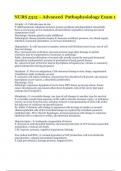
-
NURS 5315 – Advanced Pathophysiology Exam 1.
- Exam (elaborations) • 40 pages • 2023
- Available in package deal
-
- $15.99
- 1x sold
- + learn more
NURS 5315 – Advanced Pathophysiology Exam 1. Atrophy - E. Cells decrease in size P. Still functional; imbalance between protein synthesis and degradation. Essentially there is an increase in the catabolism of intracellular organelles, reducing structural components of cell Physiologic: thymus gland in early childhood Pathological: disuse (muscle atrophy d/ decrease workload, pressure, use, blood supply, nutrition, hormonal stimulation, or nervous stimulation) Hyperplasia - E: cells inc...
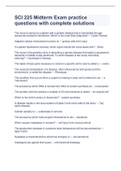
-
SCI 225 Midterm Exam practice questions with complete solutions | Latest 2023/2024
- Exam (elaborations) • 7 pages • 2023
- Available in package deal
-
- $10.49
- 1x sold
- + learn more
SCI 225 Midterm Exam practice questions with complete solutions | Latest 2023/2024 The nurse is caring for a patient with a genetic disease that is transmitted through autosomal recessive inheritance. Which is the most likely diagnosis? -- Cystic Fibrosis Adaptive cellular mechanisms function to: -- protect cells from injury If a patient liquefactive necrosis, which organ should the nurse asses first? -- Brain The nurse in the genetics clinic is describing a genetic disease that leads to pr...
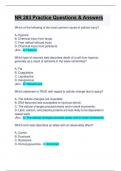
-
Practice Questions : NR 283: NR 283 Practice Questions & Answers: Updated A+ Guide Solution
- Exam (elaborations) • 18 pages • 2024
- Available in package deal
-
- $8.00
- + learn more
Which of the following is the most common cause of cellular injury? A. Hypoxia B. Chemical injury from drugs C. Free radical-induced injury D. Chemical injury from pollutants (Ans - A. Hypoxia Which type of necrosis best describes death of a cell from hypoxia, generally as a result of ischemia in the lower extremities? A. Fat B. Coagulative C. Liquefactive D. Gangrenous (Ans - D. Gangrenous Which statement is TRUE with regard to cellular change due to aging? A. The cellula...
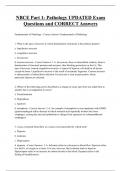
-
NBCE Part 1- Pathology UPDATED Exam Questions and CORRECT Answers
- Exam (elaborations) • 38 pages • 2024
-
- $9.49
- + learn more
NBCE Part 1- Pathology UPDATED Exam Questions and CORRECT Answers Fundamentals of Pathology - Correct Answer- Fundamentals of Pathology 1. What is the type of necrosis in which denaturation of proteins is the primary pattern? a. liquefactive necrosis b. coagulative necrosis c. fat necrosis d. caseous necrosis - Correct Answer- 1. b. In necrosis, there is intracellular acidosis; there is denaturation of structural proteins and enzymes, thus blocking proteolysis or the Ca. This type of...

-
Test Bank For Gould's Pathophysiology for the Health Professions 7th Edition Van Meter and Hubert Chapter 1-28 | Newest Version
- Exam (elaborations) • 233 pages • 2023
-
- $34.49
- 4x sold
- + learn more
Test Bank For Gould's Pathophysiology for the Health Professions 7th Edition Van Meter and Hubert Chapter 1-28 | Newest Version. The best definition of the term prognosis is the a. precipitating factors causing an acute episode. b. number of remissions to be expected during the course of a chronic illness. c. predicted outcome or likelihood of recovery from a specific disease. d. exacerbations occurring during chronic illness. ANS: C 4. Which of the following is considered a systemic sign...
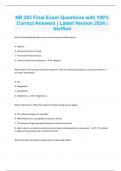
-
NR 283 Final Exam Questions with 100% Correct Answers | Latest Version 2024 | Verified
- Exam (elaborations) • 18 pages • 2024
-
- $12.49
- + learn more
Which of the following is the most common cause of cellular injury? A. Hypoxia B. Chemical injury from drugs C. Free radical-induced injury D. Chemical injury from pollutants - A. Hypoxia Which type of necrosis best describes death of a cell from hypoxia, generally as a result of ischemia in the lower extremities? A. Fat B. Coagulative C. Liquefactive D. Gangrenous - D. Gangrenous Which statement is TRUE with regard to cellular change due to aging? A. The cellular changes are reversi...
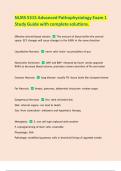
-
NURS 5315 Advanced Pathophysiology Exam 1 Study Guide with complete solutions |Latest 2024/2025
- Other • 12 pages • 2024
- Available in package deal
-
- $10.49
- + learn more
Effective arterial blood volume The amount of blood within the arterial space- ECF changes will cause changes in the EABV in the same direction Liquefactive Necrosis nerve cells- brain- accumulation of pus Caseous Necrosis lung disease- usually TB- tissue looks like clumped cheese Fat Necrosis breast, pancreas, abdominal structures- creates soaps Gangrenous Necrosis Dry- dark shriveled skin Wet- internal organs- can lead to death Gas- from clostridium- antitoxins and hype...
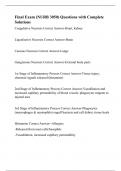
-
Final Exam (NURB 3050) Questions with Complete Solutions
- Exam (elaborations) • 9 pages • 2024
-
- $15.49
- + learn more
Coagulative Necrosis Correct Answer-Heart, kidney Liquefactive Necrosis Correct Answer-Brain Caseous Necrosis Correct Answer-Lungs Gangrenous Necrosis Correct Answer-External body parts 1st Stage of Inflammatory Process Correct Answer-Tissue injury; chemical signals released (histamine) 2nd Stage of Inflammatory Process Correct Answer-Vasodilation and increased capillary permeability of blood vessels; phagocytes migrate to injured area 3rd Stage of Inflammatory Process Correct ...

-
PATHO 370 Week 5 Midterm Exam 2023 COMPLETE
- Exam (elaborations) • 12 pages • 2023
- Available in package deal
-
- $13.49
- 1x sold
- + learn more
PATHO 370 Week 5 Midterm Exam 2023 COMPLETE. Rheumatic heart disease is most often a consequence of β-hemolytic streptococcal infection. 25.How do clinical conditions that increase vascular permeability cause edema? By allowing plasma proteins to leak into the interstitial fluid, which draws in excess fluid by increasing the interstitial fluid osmotic pressure 26.In contrast to all other types of shock, the hyperdynamic phase of septic shock is associated with high cardiac output 27.Aft...
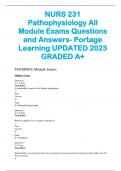
-
NURS 231 Pathophysiology All Module Exams Questions and Answers- Portage Learning UPDATED 2023 GRADED A+
- Exam (elaborations) • 74 pages • 2023
-
Available in package deal
-
- $23.59
- 1x sold
- + learn more
NURS 231 Pathophysiology All Module Exams Questions and Answers- Portage Learning UPDATED 2023 GRADED A+ PATHOPHYS Module Exams Module 1 Exam Question 1 2.5 / 2.5 pts True/False: A bodybuilder’s muscles will display hyperplasia. True Correct! False It will display hypertrophy. Question 2 2.5 / 2.5 pts True/False: Barrett esophagus is an example of dysplasia. True Correct! False It’s metaplasia. Question 3 0 / 2.5 pts True/False: Hypertrophy is an inc...

How did he do that? By selling his study resources on Stuvia. Try it yourself! Discover all about earning on Stuvia


